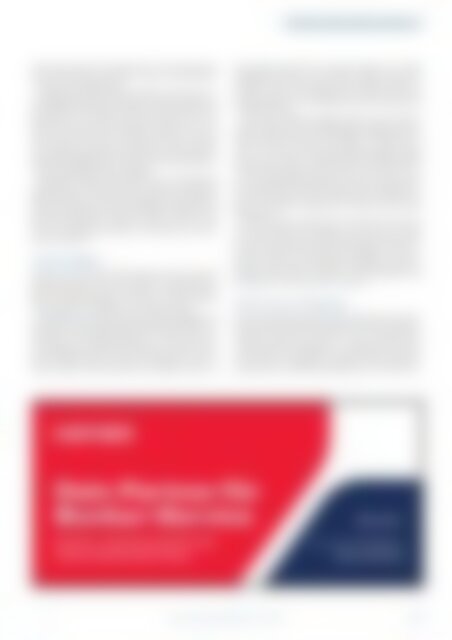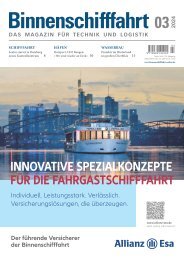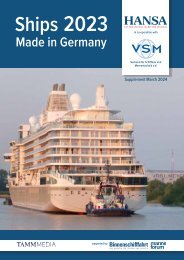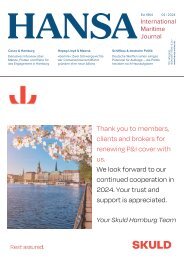HANSA 03-2024
HullPIC 24 · Offshore-Wasserstoff · Forschungsschiffe · Royal Bodewes Shipyard · St. Lawrence & Great Lakes · Schiffbau und Häfen in Nordamerika · Flag State Performance · Schifffahrts-Essen 2024
HullPIC 24 · Offshore-Wasserstoff · Forschungsschiffe · Royal Bodewes Shipyard · St. Lawrence & Great Lakes · Schiffbau und Häfen in Nordamerika · Flag State Performance · Schifffahrts-Essen 2024
Erfolgreiche ePaper selbst erstellen
Machen Sie aus Ihren PDF Publikationen ein blätterbares Flipbook mit unserer einzigartigen Google optimierten e-Paper Software.
SCHIFFSTECHNIK | SHIP TECHNOLOGY<br />
based on full-scale data. This application is in line with the initial<br />
vision of ISO 19<strong>03</strong>0, as it focusses on »classic« eneryg saving devices,<br />
like wake-equalizing ducts.<br />
Mads Martinsen (Mærsk Mc-Kinney Møller Center for Zero Carbon<br />
Shipping) look from a ship operator’s side on Performance of<br />
energy efficiency technologies retrofitted on containerships. Other<br />
presentations look at energy saving retrofits which used to be considered<br />
to be exotic, but are increasingly considered in view of the<br />
CII crunch. Ruth (DNV) look at Long-term verification of ALS and<br />
WASP systems. ALS stands for air-lubrication systems, WASP for<br />
wind assisted ship propulsion. Both options have enjoyed exponential<br />
growth in shipping over the past 5 years, and are expected to see<br />
continued exponential take-up in shipping.<br />
Especially for WASP systems, the business case is often difficult<br />
to establish due to high uncertainties, as energy savings depends<br />
highly nonlinearly on ship speed and operational area. Masutani<br />
(Sumitomo) elaborates on this in Navigating a sustainable future<br />
with wind-assisted ship technology: NAPA, Norsepower, and<br />
Sumitomo‘s collaborative journey. The business case is there,<br />
often, but sophisticated performance monitoring is the best approach<br />
to quantify it.<br />
Artificial intelligence<br />
»Ebony and ivory, living in perfect harmony« came to my mind<br />
looking at the papers of this year’s HullPIC. Not thinking about a<br />
piano keyboard, but how the discussion on black-box models<br />
based on Artificial Intelligence and white-box models based on<br />
first-principles CFD simulations has evolved since 2016.<br />
There had been controversy around Artificial Intelligence in<br />
performance monitoring already during the development of<br />
ISO 19<strong>03</strong>0. The standard accepted CFD simulation as a standard<br />
approach to establishing baselines, i.e., the speed-power<br />
curves defining the ship’s calm-water performance for various<br />
drafts. Methods based on machine learning from data collected<br />
on ships, on the other hand, were relegated to Part 3 of<br />
the standard, deemed to be not mature enough or not enough<br />
independent experience was available to judge accuracy and<br />
reliability. Both first-principles and machine learning approaches<br />
continue to be developed, but a notable trend is the<br />
combination of the two, exploiting the respective strong points<br />
of both approaches.<br />
CFD is very valuable for insight into flows, and we continue<br />
to gain insight into CFD through dedicated validation data, ultimately<br />
increasing accuracy and reliability of CFD approaches<br />
which continue to become increasingly accessible, also in<br />
terms of cost. Most CFD validation has been against model<br />
tests, for good reasons. Model tests allow controlled ambient<br />
conditions and detailed measurements of flow details are easier.<br />
Alas, ship hydrodynamicists are well aware of the scale effects,<br />
making the flow around the full-scale real ship quite different<br />
from model-scale flows. While results for model tests are<br />
quite close together, extrapolations to full scale show much<br />
larger scatter.<br />
Dmitriy Ponkratov (JoRes) presents What did we learn from<br />
the ship scale blind CFD validation exercise? There is indeed<br />
much to learn, both because the JoRes team openly shares the test<br />
case data and results, allowing other CFD groups to test their approaches.<br />
»Blind« tests are particularly insightful, as the simulators<br />
do not know the experimental results ahead of their computations.<br />
Thus, there is no chance to tweak parameters until<br />
good agreement with experiments is achieved.<br />
Deep dive into trim optimisation<br />
Inno Gatin (Cloud Towing Tank) takes a Deep dive into trim optimisation:<br />
Physical phenomena behind the fuel savings. Trim optimization<br />
shares the need for baseline curves with performance<br />
monitoring. Parallel computation in numerical towing tanks,<br />
using the cloud for computing power, has brought down costs for<br />
such systematic computations considerably. The computations<br />
are often used as a standard building block in state-of-the-art per-<br />
Dein Partner für<br />
Bunker-Service<br />
Betriebs- und Schmierstoffe für den<br />
sicheren Betrieb Deiner Flotte.<br />
Infos unter:<br />
Tel. +49 40 53798470<br />
hoyer-marine.de<br />
<strong>HANSA</strong> – International Maritime Journal <strong>03</strong> | <strong>2024</strong><br />
45

















